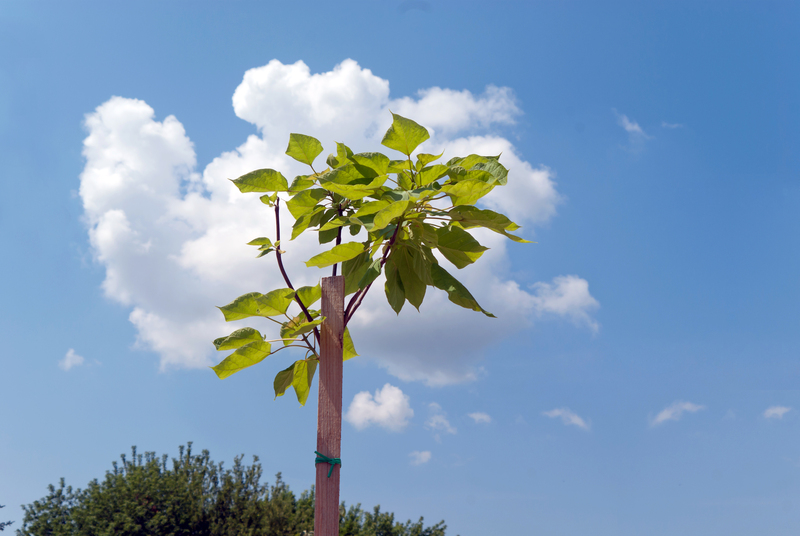Empower nature: Gardening to combat climate change
Posted on 23/06/2025
Empower Nature: Gardening to Combat Climate Change
Gardening has always been a source of beauty, relaxation, and sustenance. But did you know your backyard or balcony garden can be a powerful tool in the fight against climate change? From sequestering carbon to supporting wildlife and conserving water, gardens deliver big environmental benefits. This comprehensive guide delves into how you can empower nature through gardening, making your patch of green part of the solution to global climate issues.
Why Gardening Matters in the Climate Change Battle
Climate change threatens ecosystems, food security, and human well-being on a global scale. While technological innovation and policy are essential, nature-based solutions like gardening offer everyday citizens actionable ways to create positive change. By choosing eco-friendly techniques, gardeners can reduce their carbon footprint, enhance biodiversity, and help combat global warming--one seed at a time.
Gardening: A Personal Solution With Global Impact
- Plants absorb CO2: Through photosynthesis, plants draw carbon dioxide--a greenhouse gas--out of the atmosphere and store it.
- Gardens support biodiversity: Pollinator-friendly gardens foster healthy local ecosystems and wildlife.
- Soil is a carbon sink: Healthy, undisturbed soil in gardens stores significant amounts of carbon, more than previously understood.
- Gardening reduces food miles: Growing your own food shrinks the environmental cost of transportation and packaging.
- Gardeners can conserve water: By harvesting rainwater and choosing drought-tolerant plants, gardeners support resilient landscapes.

Key Ways to Fight Climate Change with Gardening
To empower nature by gardening for climate change action, rethink your gardening choices and techniques. Here's a comprehensive look at how your garden can evolve into a climate-friendly powerhouse.
1. Choose Climate-Resilient and Native Plants
Native plants have adapted to your local climate over thousands of years. They're naturally drought-tolerant, disease-resistant, and provide vital habitat for wildlife. Integrating local species into your landscape means:
- Using less water
- Reducing the need for chemical fertilizers and pesticides
- Supporting pollinators like bees, butterflies, and birds
Example: In the U.S. Midwest, planting coneflower, milkweed, and prairie grasses makes gardens more resilient and eco-friendly.
2. Practice Organic and Regenerative Gardening
Avoiding synthetic pesticides and fertilizers limits pollution and improves soil health. Regenerative practices not only sustain but actively improve the soil's ability to sequester carbon. Key techniques include:
- Composting: Turns waste into nutrient-rich soil and reduces methane from landfills.
- Mulching: Protects soil, retains moisture, suppresses weeds, and adds organic matter.
- No-till gardening: Minimizes soil disturbance, helping lock carbon below ground.
- Planting cover crops: Grasses or legumes enrich soil and prevent erosion in off-seasons.
3. Design for Water Efficiency
Water resources are under growing stress. With climate change, droughts and heavy rains are more common. Smart garden design can minimize runoff and waste:
- Install rain barrels to collect water for garden use.
- Use drip irrigation and soaker hoses for targeted watering.
- Plant in groupings according to water needs for efficiency.
- Choose permeable paths (e.g., gravel, wood chips) to increase soil absorption.
Tip: Mulching reduces evaporation and prevents weeds--critical for climate-adaptive gardens.
4. Create Wildlife-Friendly Habitats
A thriving garden helps restore nature's balance by drawing back pollinators, birds, and beneficial insects. Wildlife gardening for climate change involves:
- Planting a diversity of flowers for overlapping bloom times
- Allowing some areas to be untamed as shelter for wildlife
- Setting up bee hotels and bird houses
- Minimizing light pollution to protect nocturnal creatures
5. Reduce Lawn, Increase Plant Coverage
Traditional lawns require high inputs of water, fertilizer, and mowing (fossil fuels). By replacing grass with garden beds, groundcovers, or wildflower meadows, you:
- Use fewer fossil fuels and chemicals
- Increase biodiversity and soil health
- Improve carbon sequestration
Gardening Techniques That Empower Nature and Help the Climate
Composting: Turning Waste into Climate Action
Composting food scraps and yard waste returns essential nutrients to your garden and prevents methane emissions from landfill decomposition. Methane is a potent greenhouse gas--over 25 times more effective at trapping heat than CO2.
- What to compost: Vegetable scraps, coffee grounds, eggshells, leaves, grass clippings.
- What to avoid: Meat, dairy, oily foods--these attract pests and slow decomposition.
- How to compost: Choose a bin or pile, keep moist, turn regularly for aeration.
With compost, you replace chemical fertilizers and boost carbon-rich soil, a practical way to foster a climate-friendly garden ecosystem.
Permaculture and Carbon Farming in Home Gardens
Permaculture principles prioritize closed loops and working with nature--not against it. Carbon farming techniques, though often used at larger scales, can be adapted to backyards:
- Plant a food forest: Combine fruit trees, shrubs, perennials and herbs for layers of productivity and ecological services.
- Polyculture beds: Grow diverse crops together to mimic natural systems and reduce pest problems.
- Swales and berms: Shape landforms to capture water, prevent erosion, and grow healthy, carbon-rich soils.
Reducing Chemical Inputs and Fossil Fuels
Lawnmowers, leaf blowers, and chemical treatments all contribute to greenhouse gas emissions and pollute local waterways. Sustainable gardeners can:
- Switch to electric or manual tools
- Embrace natural pest control like beneficial insects, barriers, and companion planting
- Make your own natural fertilizers using compost or plant teas
Every step toward organic and fossil-free gardening multiplies the positive effects on climate mitigation.
How Urban Gardening Empowers Cities in the Fight Against Climate Change
Climate-friendly gardening isn't reserved for those with big yards. Urban gardening--on rooftops, balconies, and community plots--plays a vital role in fighting urban heat, air pollution, and food insecurity.
Benefits of Urban and Community Gardens
- Lowering city heat: Green roofs and plantings absorb less heat than bare surfaces.
- Improving air quality: Plants filter dust and pollutants from the air.
- Expanding green spaces: Even small pocket gardens provide homes for birds and insects.
- Community resilience: Sharing knowledge and resources helps neighborhoods adapt to climate challenges.
Tip: If you lack a yard, join a local community garden or volunteer for a tree planting project--every bit helps!
Cutting Food Miles: Grow What You Eat
Industrial agriculture uses vast amounts of energy in planting, watering, harvesting, processing, and shipping food worldwide. By growing fruits, vegetables, and herbs at home, you:
- Reduce carbon emissions from food transport and storage
- Eat more seasonally and fresh
- Compost your scraps to cycle nutrients locally
Even a few potted tomatoes, kitchen herbs, or salad greens can cut your carbon footprint and foster a deeper connection with your food.
Climate Gardening: Getting Started
Basic Steps for a Climate-Conscious Garden
- Assess your space and climate: Consider sunlight, rainfall, and soil type.
- Select native or adapted plants proven to thrive with less intervention.
- Start composting using kitchen and garden waste.
- Replace some lawn with garden beds, wildflowers, or groundcovers.
- Install water-saving features like rain barrels or drip irrigation.
- Avoid pesticides and chemical fertilizers.
- Welcome wildlife with pollinator plants and natural shelter.
Gardening for Change: Tips and Resources
- Connect with local gardeners for advice on what grows well in your area
- Join a native plant society for guidance and plant sales
- Read books, webinars, and blogs focused on organic and regenerative gardening
- Support green nurseries and seed companies committed to sustainability
Empower Nature: The Cumulative Impact of Climate-Conscious Gardening
What if millions of gardeners worldwide adopted these principles? The cumulative effect would greatly increase carbon storage, restore habitats, cut pollution, and empower nature itself to fight back against climate change. As we adapt to a changing world, small actions matter--especially when multiplied by collective effort.
Your garden is more than a private retreat--it's a key part of a global environmental solution.
Gardening to Empower Nature and Combat Climate Change: A Call to Action
Climate change can feel overwhelming, but every gardener has the power to nurture a healthier, greener future. By choosing climate-friendly methods, advocating in your community, and spreading the word, you become a force for positive change.
- Start with small, achievable steps--even one native plant or a compost bin makes a difference
- Share your successes and failures to inspire others
- Advocate for greener community spaces and policies that support natural solutions

Conclusion: Gardening for a Greener Tomorrow
Empowering nature through gardening is an act of hope and stewardship. Whether your plot is large or small, city or countryside, you can be a climate hero. Gardening to combat climate change is about growing a better world--rooted in the earth, reaching toward a resilient, thriving future.
Get outside, get your hands dirty, and let your garden make a global difference--one plant at a time.
FAQs: Gardening and Climate Change
Q: What are the best plants for a climate-friendly garden?
A: Choose locally native perennials, drought-tolerant trees and shrubs, legumes, and pollinator-friendly flowers. Avoid invasive species and focus on diversity.
Q: Can small gardens really help fight climate change?
A: Yes! The benefits of small gardens add up when many people participate. Even small-scale composting, water conservation, and rewilding make an impact.
Q: What's the difference between organic and regenerative gardening?
A: Organic gardening eliminates chemical inputs. Regenerative gardening goes a step further--actively building soil, sequestering carbon, and supporting ecological health.
Q: How does gardening help urban areas with climate change?
A: Green spaces cool urban heat islands, improve air quality, reduce flooding risk, and offer important habitats for city wildlife.
Q: How do I get started gardening for climate action if I'm a beginner?
A: Start small. Buy a few native plants, mulch your beds, start composting, and embrace organic practices. Join a local group or gardening forum for help and support.
Take up your trowel--the planet will thank you!

